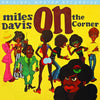





Miles Davis - On the Corner (Ultra Analog, Half-speed Mastering)
ORDER LIMITED TO ONE ITEM PER CUSTOMER
Miles Davis – electric trumpet with wah-wah, organ [click here to see more vinyl featuring Miles Davis]
Michael Henderson – bass guitar with wah-wah
Don Alias – drums, percussion
Jack DeJohnette – drums [click here to see more vinyl featuring Jack DeJohnette]
Al Foster – drums
Billy Hart – drums
James Mtume – percussion
Carlos Garnett – soprano saxophone, tenor saxophone
Dave Liebman – soprano saxophone, tenor saxophone
Bennie Maupin – bass clarinet [click here to see more vinyl featuring Bennie Maupin]
Chick Corea – Fender Rhodes, keyboards [click here to see more vinyl featuring Chick Corea]
Herbie Hancock – Fender Rhodes, keyboards [click here to see more vinyl featuring Herbie Hancock]
Harold Ivory Williams – keyboards
Cedric Lawson – organ
Dave Creamer – guitar
Reggie Lucas – guitar
John McLaughlin – guitar [click here to see more vinyl featuring John McLaughlin]
Khalil Balakrishna – electric sitar
Collin Walcott – electric sitar
Paul Buckmaster – cello
Badal Roy – tabla
1 LP, gatefold jacket
Limited numbered edition
Original analog Master tape : YES
Half-speed Mastering
Gain 2™ Ultra Analog
Heavy Press : 180g
Record color : black
Speed : 33RPM
Size : 12”
Stereo
Studio
Record Press : RTI
Label : MOFI
Original Label : Columbia
Recorded June 1, 6 and July 7, 1972 at Columbia Studio E, New York City
Engineered by Russ Payne, Stan Tonkel
Produced by Teo Macero
Remastered by Krieg Wunderlich
Originally released in 1972
Reissued in 2016
Tracks:
Side A :
- On the Corner/New York Girl/Thinkin' One Thing and Doin' Another/Vote for Miles
- Black Satin
Side B :
- One and One
- Helen Butte/Mr. Freedom X
Reviews :
"Could there be any more confrontational sound in Miles Davis' vast catalog than the distorted guitars and tinny double-timing drums reacting to a two-note bass riff funking it up on the first track from On the Corner? Before the trumpet even enters the story has been broken off in the middle -- deep street music melding with a secret language exchanged by the band and those who can actually hear it as music. Here are killer groove riffs that barely hold on as bleating trumpet and soprano sax lines (courtesy of Dave Liebman on track one) interact with John McLaughlin's distortion-box frenzy. Michael Henderson's bass keeps the basic so basic it hypnotizes; keyboards slowly enter the picture, a pair of them handled by Herbie Hancock and Chick Corea, as well as Ivory Williams' synthesizer. Finally, Colin Walcott jumps in with an electric sitar and there are no less than five drummers -- three kits (Al Foster, Billy Hart, and Jack DeJohnette), a tabla player, and Mtume. It's a four-tune suite, On the Corner is, but the separations hardly matter, just the shifts in groove that alter the time/space continuum. After 20 minutes, the set feels over and a form of Miles' strange lyricism returns in "Black Satin." Though a tabla kicks the tune off, there's a recognizable eight-note melody that runs throughout. Carlos Garnett and Bennie Maupin replace Liebman, Dave Creamer replaces McLaughlin, and the groove rides a bit easier -- except for those hand bells shimmering in the background off the beat just enough to make the squares crazy. The respite is short-lived, however. Davis and band move the music way over to the funk side of the street -- though the street funkers thought these cats were too weird with their stranded time signatures and modal fugues that begin and end nowhere and live for the way the riff breaks down into emptiness. "One and One" begins the new tale, so jazz breaks down and gets polished off and resurrected as a far blacker, deeper-than-blue character in the form of "Helen Butte/Mr. Freedom X," where guitars and horns careen off Henderson's cracking bass and Foster's skittering hi-hats. It may sound weird even today, but On the Corner is the most street record ever recorded by a jazz musician. And it still kicks." AllMusic Review by Thom Jurek
Ultra Analog™ : The GAIN 2 Ultra Analog™ Series stems from the use of the Gain 2 system, mastered at half speed from the original master tapes where possible, capturing and uncovering as before undiscovered sonic information.
Half-speed mastering. In half-speed mastering, the whole process is slowed down to half of the original speed. A typical 33 1/3 rpm record is cut at 16 2/3 rpm. The source material is also slowed down (reducing the pitch in the process) meaning the final record will still sound normal when played back. Slowing the whole process down allows more time, which means the end result sounds better and is more efficient — allowing engineering to minimize the effects of inherent limitations within the vinyl format. The result is a more accurate and more open high-frequency response in the half speed vinyl when compared with a normal speed recording.
Ratings :
AllMusic : 5 / 5 , Discogs : 4,52 / 5


